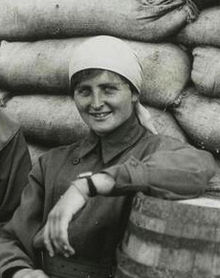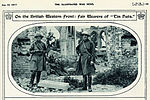Mairi Chisholm
Mairi Chisholm | |
|---|---|
 | |
| Born | Mairi Lambert Gooden Chisholm 26 February 1896 Datchet, England |
| Died | 22 August 1981 (aged 85) Perth, Scotland |
| Years active | 1914–1918 |
| Medical career | |
| Profession | Nurse |
| Awards |
|
Mairi Lambert Gooden Chisholm, of Chisholm, MM, OStJ (26 February 1896 – 22 August 1981) was a Scottish nurse and ambulance driver in the First World War. She, together with her friend Elsie Knocker, won numerous medals for bravery and for saving the lives of thousands of soldiers on the Western Front in Belgium. Dubbed "The Madonnas of Pervyse" by the press[1][2] the two were among the most photographed women of the war.[3]
Early life
[edit]This section needs additional citations for verification. (December 2022) |
Chisholm was born on 26 February 1896 in Buckinghamshire [4] to Captain Roderick Gooden-Chisholm, Chief of Clan Chisholm, and Margaret Fraser. Her family was independently wealthy and owned a plantation in Trinidad. As a teen, she witnessed her older brother, Uailean, who owned a Royal Enfield 425cc motorcycle, competing at rallies and at the Bournemouth speed trials. Around this time, and against his wife's wishes, her father bought her a Douglas motorbike. Chisholm spent hours in the family stables stripping down the bikes and repairing them. She was just 18 years old when, while roaring round the Hampshire and Dorset lanes, she met thirty-year-old Elsie Knocker, a divorcee and mother of a young son. They became fast friends and soon began competing in motorcycle and sidecar trials together.
World War I
[edit]This section needs additional citations for verification. (July 2023) |
When war was declared in 1914, Knocker wrote to Chisholm that there was "work to be done",[5] and suggested they go to London to become dispatch riders for the Women's Emergency Corps.[6]
Chisholm rode her motorbike all the way from Dorset to the capital. It was while acting as a courier in this way that she was spotted making hairpin corners in the city by Dr Hector Munro. Munro was setting up a Flying Ambulance Corps to help the Belgians who had been caught unawares by the German invasion and invited her to join his team, as she describes in a June 1976 interview: "[Munro] was deeply impressed with my ability to ride through the traffic. He traced me to the Women's Emergency Corps and... said, 'Would you like to go out to Flanders' and I said 'Yes, I'd love to'."[7]
Both she and Knocker ended up in Belgium as part of the corps which included Lady Dorothie Feilding and May Sinclair. Initially quartered at Ghent, the unit relocated to Veurne at the end of October where the women worked tirelessly, picking up wounded soldiers mid-way from the front and transporting them back to their field hospital at the rear. After the beds ran out, the wounded were laid on the floor or propped up against the wall. As the dead piled up, the two nurses were told to remove them to the mortuary. Chisholm wrote in her diary: "No one can understand ... unless one has seen the rows of dead men laid out. One sees men with their jaws blown off, arms and legs mutilated."[8]
Chisholm and Knocker soon came to the conclusion that they could save more lives by treating the wounded directly on the front lines. In November, they decided to leave the corps and set up their own dressing station five miles east in a town named Pervijze, north of Ypres, just one hundred yards from the trenches. Here, in a vacant cellar which they named "Poste de Secours Anglais" ("British First Aid Post"), the two would spend the next three and a half years tending to the wounded. No longer affiliated with the Belgian Red Cross, they began acting completely as free agents and had to support their work by raising their own funds. Through sheer perseverance Knocker was able to arrange for the two of them to be officially seconded to the Belgian garrison stationed there. In January 1915, they were both decorated by King Albert I of Belgium with the Order of Léopold II, Knights Cross (with palm)[5] for their courageous work on the front lines.
They were also awarded the British Military Medal and both made Officers of the Most Venerable Order of St. John of Jerusalem.[5] Chisholm was also decorated with the Queen Elisabeth Medal of Belgium and the British campaign medals, including the 1914 Star.
In 1916, Chisholm became engaged to a Royal Naval Air pilot named Jack Petrie, who died a year later during flying practice. In 1918, both women were badly affected by a massive bombing raid and gas attacks on their makeshift field hospital. Chisholm recovered enough to return to the front, before being forced to abandon her post just months before the end of the war. She returned to Britain, where both she and Knocker saw out the rest of the war as members of the newly formed Women's Royal Air Force.[9]
Post-war years
[edit]Following the end of the war, the two nurses continued to be feted by the public and the press. Eventually they went their separate ways when Chisholm learned the truth about Knocker's divorce from her first husband; since Edwardian English society frowned upon divorce, Knocker had previously maintained the fiction that she was a widow. The two barely spoke again. The war had taken its toll on Chisholm's health. She had been poisoned, contracted septicaemia, and had a weak heart.
She did, however, continue to live her life at a fast pace. After her brief stint in the WRAF, she took up motor racing. On one occasion, she was scheduled to take part in a race at Brooklands but had to withdraw because of a fainting episode the evening before.
Final years of and death
[edit]Partly on doctors' advice, Chisholm returned to Nairn, where, it was hoped, she would lead a quieter life. There she became a successful poultry breeder with her childhood friend, May Davidson on the Davidson's family estate. In the 1930s they relocated their business to Jersey.[10]
Her final move was to Cnoc an Fhurain, Rhugarbh, Barcaldine, Argyll, where she, May, "Bird" Partridge and "John" Johnstone, ran a poultry farm for decades. In her later years she spent much time corresponding with The Clan Chisholm Society,[10] which she established in 1972.[11]
Mairi Chisholm died on 22 August 1981 of lung cancer, aged 85, in Perth Hospital.[12]
Awards and decorations
[edit]Papers and archives
[edit]National Library of Scotland holds five volumes of papers and photographs that belonged to Chisholm. The photographs are a valued source of information as they give a candid portrayal of the wartime experiences of Chisholm and Knocker in contrast to the official photos of the period, which tend to avoid scenes that might challenge the 'official' account of the war.[17]
The Imperial War Museum holds Chisholm's diaries along with recordings and transcripts of interviews.[17]
Memorials
[edit]In November 2014 a statue of Chisholm and Elsie Knocker was unveiled in the garden of the Hotel Ariane in Ypres, Belgium.[18]
Gallery
[edit]-
Knocker and Chisholm in their converted Wolseley Ambulance, Pervyse, Belgium, c. 1916
-
Knocker and Chisholm pose in the ruins of a church in Pervyse, Belgium for "Illustrated War News", 22 April 1917
-
Chisholm and Knocker wearing their Tommy helmets. Pervyse, Belgium, c. 1917
-
Chisholm and Knocker display their Order of Léopold II, medals. On their headscarves is the insignia of the Belgian Army's 3rd Division, c. 1918
-
Knocker and Chisholm on the cover of "Home Chat" magazine, 11 April 1918
-
Knocker and Chisholm outside their advanced dressing station, Pervyse, Belgium, c. 1918
See also
[edit]Bibliography
[edit]- Atkinson, Diane. Elsie and Mairi Go to War: Two Extraordinary Women on the Western Front. Cornerstone. (2009)
- Hallam, Andrew & Nicola. Lady Under Fire on the Western Front: The Great War Letters of Lady Dorothie Feilding MM. Pen & Sword Military. (2010)
- Mitton, Geraldine Edith, T'Serclaes, Baroness Elsie de, Chisholm, Mairi. The Cellar-House of Pervyse : A Tale of Uncommon Things from the Journals and Letters of the Baroness T'Serclaes and Mairi Chisholm. A.C. Black. (1917)
- T'Serclaes, Elsie Baroness de. Flanders and Other Fields. Harrap. (1964)
References
[edit]- ^ Albrinck, Meg (1999). Crossing No Man's Land: Gender Confusion and Genre Disruption in British Women's War Narratives. University of Wisconsin–Madison. p. 160.
- ^ Brown, Malcolm (1991). The Imperial War Museum Book of the First World War. Sidgwick & Jackson. pp. 186–189. ISBN 978-0-283-99946-8.
- ^ The War Illustrated, (June 1915)
- ^ England & Wales, Civil Registration Birth Index, 1837-1915 Volume 3a Page 702
- ^ a b c Knocker, Elsie [Baroness de T'Serclaes] (1964). Flanders and Other Fields Harrap, London
- ^ Clan Chisholm Society of New Zealand Newsletter #47, August 2009[dead link]
- ^ Imperial War Museum (June 1976). "IWM interview [with Mairi Chisholm, Reel 1, from 00:03:27:00]". IWM Collections Search. Retrieved 20 April 2013.
- ^ Imperial War Museum transcript: "Welcome the Imperial War Museum's Collections Home Page". Archived from the original on 14 April 2010. Retrieved 2 August 2010.
- ^ Gleason, Arthur (1916). Golden Lads The Century Co., New York
- ^ a b Atkinson, Diane (2009). 'Elsie and Mairi Go to War: Two Extraordinary Women on the Western Front', Cornerstone Publishing.
- ^ Biographical Dictionary of Scottish Women
- ^ "Mairi Chisholm". Oxford Dictionary of National Biography (online ed.). Oxford University Press. doi:10.1093/ref:odnb/67674. ISBN 978-0-19-861412-8. Retrieved 18 June 2020. (Subscription or UK public library membership required.)
- ^ "Edinburgh Gazette, 28 October 1927, page 1204". Retrieved 16 December 2017.
- ^ "London Gazette, Supplement 19 November 1917, page 11961". Retrieved 16 December 2017.
- ^ a b c "Campaign medal card of Mairi Gooden-Chisholm, British Red Cross Society". The National Archives. Retrieved 14 December 2017.
- ^ a b "Medals awarded to Miss Gooden-Chisholm, B.R.C.S." National Army Museum. Retrieved 16 December 2017.
- ^ a b National Library of Scotland. "Experiences of War". National Library of Scotland.
- ^ "Fitting Tribute to WWI nursing angels". The Sunday Post. 30 November 2014.
External links
[edit]- Online text
- Elsie And Mairi Go To War: Two Extraordinary Women On The Western Front (2009) by Diane Atkinson at Kobo
- The Cellar-House of Pervyse (1917) at Internet Archive
- A Surgeon in Belgium (1915) by Henry Sessions Souttar at Google Books
- Young Hilda at the Wars (1915) by Arthur Gleason at Internet Archive
- Golden Lads (1916) by Arthur Gleason & Helen Hayes Gleason at Internet Archive
- 'How War Seems to a Woman'; Excerpt from: The Golden Lads (1916) by Arthur Gleason & Helen Hayes Gleason at greatwardifferent.com
- Women and War Work (1918) by Helen Fraser; Chapter IV. at LexCycle Library
- Women and war: a historical encyclopedia from antiquity to the present, Volume 1 (2006) by Bernard A. Cook at Google Books
- Digital archives
- 'The Nurses Story: Tending the Wounded at the Front' at National Library of Scotland.
- 'The Women of Pervyse' at the Imperial War Museum
- 'The medals of Mairi Chisholm' at the Imperial War Museum
- 'Women at War: The Two Women of Pervyse' at the BFI National Archive.
- Works by Mairi Chisholm at LibriVox (public domain audiobooks)







